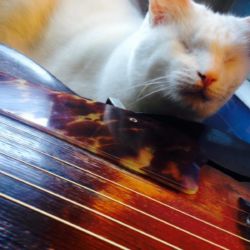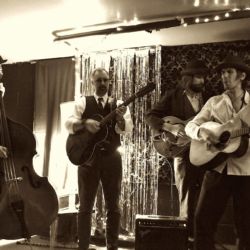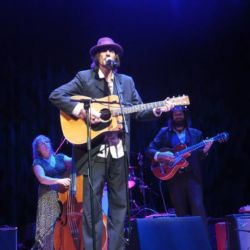WWII-era Harmony H700 (?) archtop
- Body: Birch
- Neck: Mahogany
- Hardware: Stock
- Pickups: Fishman SBT-E Soundboard Transducer
Speculating on the model, as there are no labels or serial numbers, but mid-40’s is a pretty good guess at the date, as there’s a wooden tailpiece, which you often find on guitars built during WWII-era metal rationing. The body is made from birch, thoughtfully painted with grain to look like spruce. So named due to the original owner painting her handle on the fibre case. Not a loud guitar, and the neck is massive (probably because it lacks a truss rod), but works pretty well for “sock rhythm.”
What is that, you ask? Sock rhythm is the standard rhythm for swing and classic jazz. It is composed of pairs of downstrokes. The first stroke rings a little longer, and the second is a chop (i.e., quickly muted), so the downbeat and upbeat each have their own accent. Very simple to demonstrate, but very difficult to do well. It is like “daaa-da, daaa-da,” etc. It is a must if you want to play swing, also used in classic country music from days before they allowed drums, and even Cajun rhythm. Flatt & Scruggs had a sock guitarist in their group after they stopped having a mandolin player, and Ricky Skaggs currently employs one in his Kentucky Thunder band.
Right now Heidi is loaded with D’Addario NB .13.-.56, but I may experiment with Chrome half-rounds.












